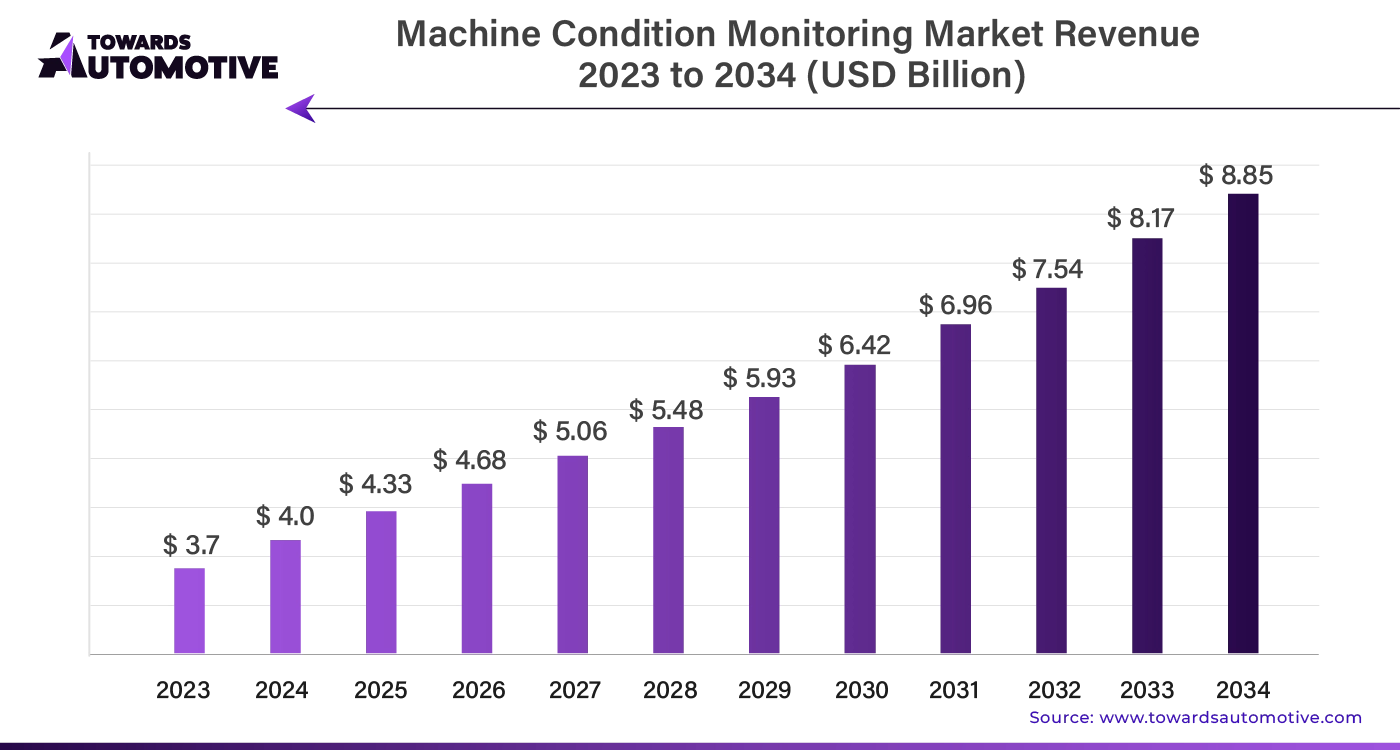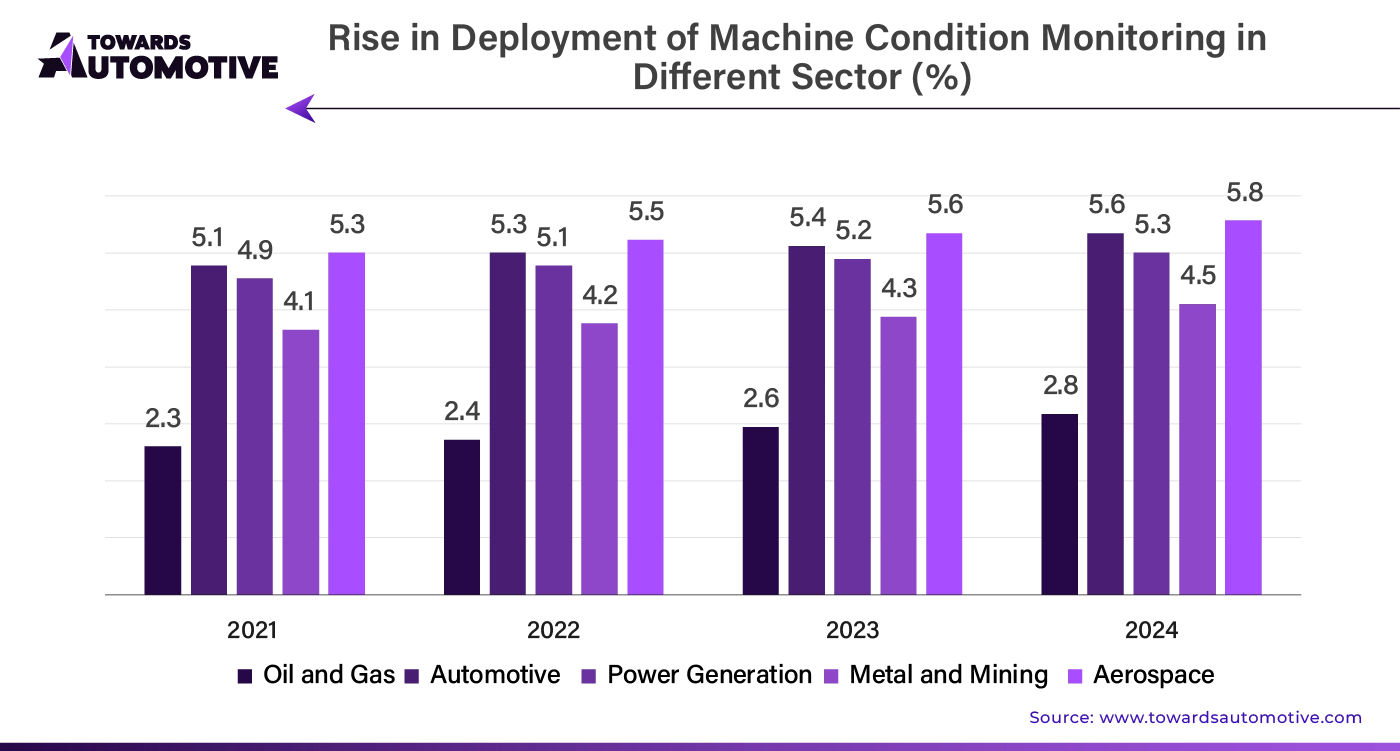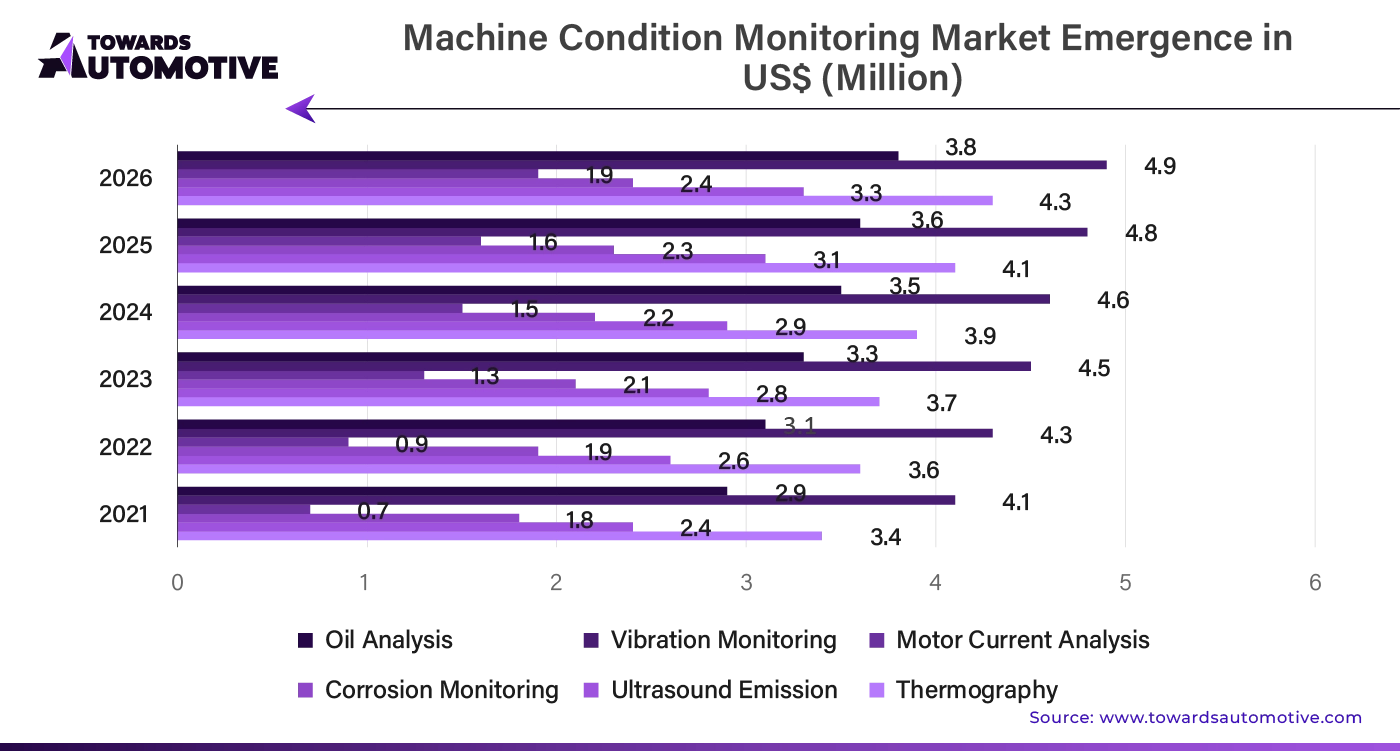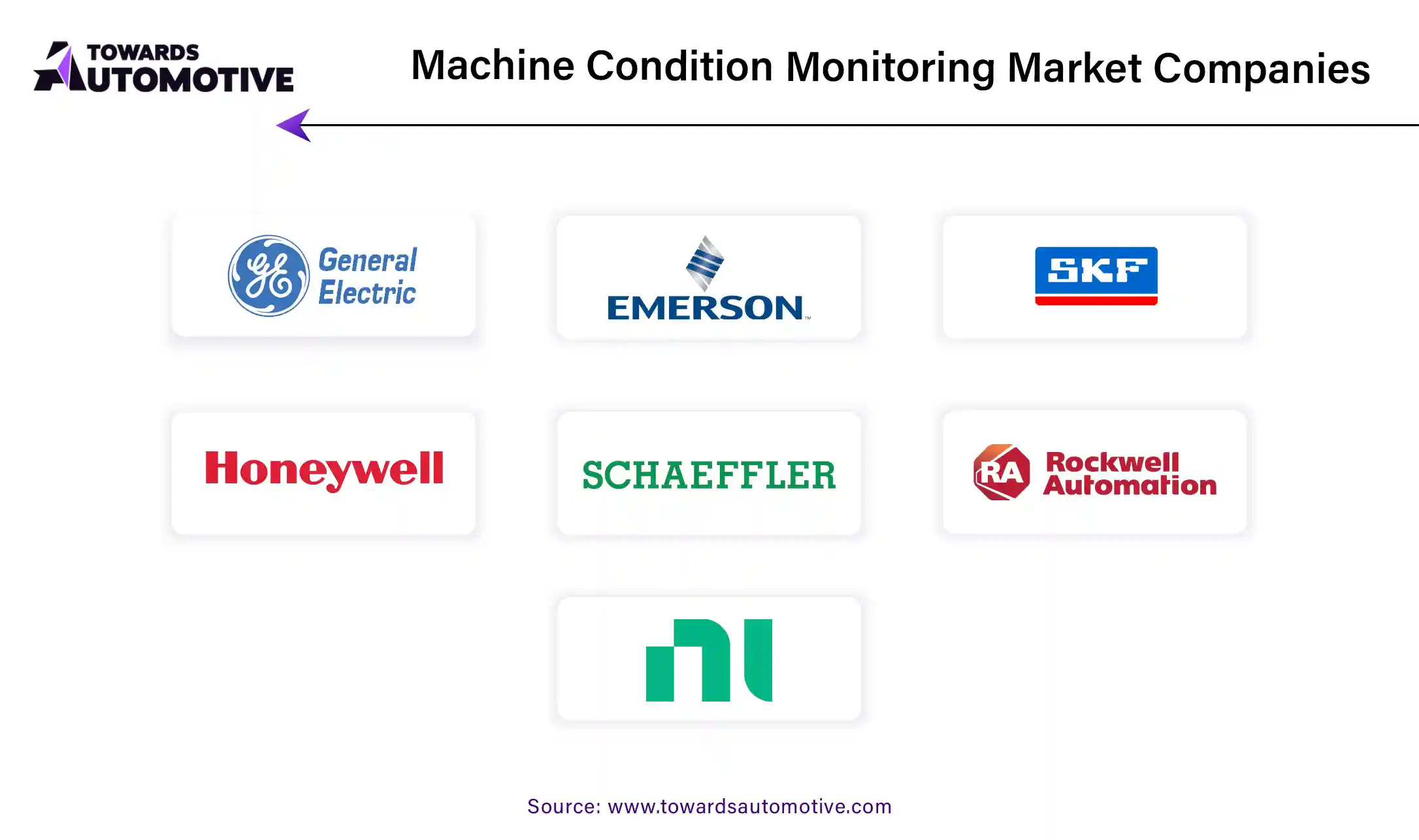March 2025
The machine condition monitoring market is forecast to grow from USD 4.33 billion in 2025 to USD 8.85 billion by 2034, driven by a CAGR of 8.1% from 2025 to 2034.

Unlock Infinite Advantages: Subscribe to Annual Membership
Machine condition monitoring is undergoing a transformative shift driven by technological advancements, regulatory pressures, and a heightened focus on operational efficiency. This sector is poised for significant growth as industries across the globe increasingly adopt predictive maintenance strategies to optimize equipment performance and ensure safety.
Technological Advancements
Recent developments in sensor technology, data analytics, and artificial intelligence are revolutionizing machine condition monitoring. Modern sensors provide precise, real-time data on equipment performance, while advanced analytics and AI algorithms enable deeper insights into machine health. These technologies facilitate proactive maintenance by predicting potential issues before they become critical, thus minimizing downtime and extending asset life.
The automotive market valued at USD 4,070.19 billion in 2023, is experiencing growth and is projected to surpass USD 6,678.28 billion by 2032, with a significant CAGR of over 5.66%.
Integration with Industrial IoT (IIoT)
A key trend shaping the industry is the integration of machine condition monitoring systems with Industrial Internet of Things (IIoT) platforms. This connectivity allows for continuous, real-time monitoring of equipment health across various industrial environments. IIoT platforms collect and analyze data from interconnected machines, offering a comprehensive view of asset performance and enabling timely maintenance interventions.
Regulatory and Industry Standards
Regulatory requirements and industry standards related to equipment safety and environmental sustainability are becoming increasingly stringent. Compliance with these regulations necessitates the adoption of advanced monitoring systems capable of providing real-time insights into asset health. As regulations evolve, companies will be driven to invest in condition monitoring technologies to meet safety standards and environmental guidelines, thus enhancing operational efficiency and reducing risks.
Emerging Sectors and Demand
The demand for machine condition monitoring is expanding into emerging sectors, notably renewable energy. In industries such as wind and solar power, the reliability and performance of critical assets are crucial. Machine condition monitoring systems are essential for maintaining the efficiency and longevity of equipment like wind turbines and solar panels. The integration of machine learning and predictive analytics into these systems will provide more accurate and actionable insights, further driving their adoption in these sectors.

Future Outlook
The machine condition monitoring sector is set for robust growth over the next decade. Technological innovations, regulatory mandates, and the need for operational efficiency are key drivers of this expansion. Companies that invest in cutting-edge monitoring solutions will not only mitigate operational risks but also gain a competitive advantage in an increasingly dynamic business landscape.
The integration of artificial intelligence (AI) into the machine condition monitoring market is poised to drive significant growth and transformation. AI enhances machine condition monitoring by enabling real-time, predictive analysis that goes beyond traditional methods. With AI algorithms analyzing vast amounts of data from sensors, predictive maintenance becomes more precise, allowing for early detection of potential failures before they occur. This proactive approach reduces downtime and maintenance costs, optimizing machine performance and extending equipment lifespan.
AI-driven systems offer advanced diagnostics and fault detection capabilities by learning from historical data and identifying patterns that might elude human operators. These systems can adapt and improve over time, becoming increasingly accurate in predicting issues and suggesting actionable solutions. Moreover, AI facilitates automated reporting and decision-making processes, streamlining operations and reducing the need for manual intervention.
As industries continue to seek greater efficiency and cost-effectiveness, AI integration in machine condition monitoring will become a critical enabler of operational excellence. This technological advancement is set to enhance market growth by delivering more reliable, data-driven insights and fostering a shift towards smarter, more resilient maintenance strategies.
In the Machine Condition Monitoring market, the supply chain is a critical component, ensuring the seamless flow of products and services from manufacturers to end-users. The process begins with raw materials and components sourced from suppliers, which are then used by manufacturers to create condition monitoring equipment. This equipment includes sensors, data acquisition systems, and diagnostic tools essential for monitoring machinery health.
Once produced, these products move through a network of distributors and resellers who manage inventory and facilitate product availability across various regions. Efficient logistics and warehousing play a vital role in maintaining timely deliveries and minimizing disruptions. To optimize the supply chain, companies often employ advanced forecasting and inventory management systems to align supply with demand, reduce lead times, and manage costs.
End-users, including industries like manufacturing and energy, rely on this robust supply chain to obtain reliable condition monitoring solutions. As technology advances, companies in the supply chain must adapt to new innovations and integrate digital tools to enhance transparency and efficiency. By maintaining a well-coordinated supply chain, businesses can ensure consistent product quality and meet the evolving needs of the Machine Condition Monitoring market.
Machine Condition Monitoring (MCM) is vital for maintaining the efficiency and reliability of industrial machinery. This market ecosystem comprises several key components and players who each contribute uniquely.
The primary components include sensors, which gather data on machine vibrations, temperature, and other operational parameters; data acquisition systems, which collect and transmit this data for analysis; and diagnostic software, which interprets the data to predict potential failures and suggest maintenance actions.
Major players in this market include companies like SKF, Honeywell, and Siemens. SKF, for example, provides advanced sensors and monitoring equipment designed to detect issues in rotating machinery early. Honeywell offers integrated monitoring solutions with robust analytics capabilities to optimize machine performance. Siemens contributes with its sophisticated diagnostic tools and software solutions that leverage AI to enhance predictive maintenance.
In addition to these major players, smaller companies and startups are also innovating within the ecosystem, offering specialized solutions or niche technologies. Together, these entities ensure a comprehensive approach to machine condition monitoring, driving advancements in predictive maintenance and operational efficiency across various industries.
Innovations Driving Demand
The field of condition monitoring is rapidly evolving, propelled by advancements in sensor technology, data analytics, and artificial intelligence (AI). These innovations are creating more sophisticated and effective condition monitoring systems, which are increasingly vital for industries seeking to enhance operational efficiency and reduce downtime. Predictive maintenance strategies, which rely on these advanced systems, are becoming more prevalent as they offer significant cost savings and operational benefits. By predicting potential failures before they occur, companies can minimize unexpected downtimes and optimize the performance of their equipment.
For instance,

Regulatory Pressures
Stringent regulations concerning equipment safety, environmental sustainability, and worker safety are also driving the demand for advanced condition monitoring solutions. Compliance with these regulations is crucial for avoiding hefty fines and penalties, making it essential for companies to invest in reliable monitoring systems. These systems help ensure that equipment meets safety and environmental standards while also protecting workers' safety.
Challenges to Adoption
Despite the benefits, there are several challenges that could hinder the growth of the condition monitoring market:
Opportunities Through Machine Learning and IoT
The expansion of sectors such as renewable energy, aerospace, and automotive opens up new opportunities for condition monitoring solution providers. These industries require reliable monitoring of critical assets to maintain safety and efficiency. The growth of the Internet of Things (IoT) enables real-time monitoring of equipment health, facilitating proactive maintenance and reducing the likelihood of costly downtimes.
The integration of machine learning algorithms and predictive analytics into condition monitoring platforms is particularly promising. These technologies enhance the accuracy and timeliness of fault detection, allowing for more effective maintenance strategies. This integration not only improves system performance but also creates opportunities for innovation and differentiation in the market.
Competitive Pressures and Market Dynamics
The condition monitoring market is characterized by intense competition, with numerous players offering a wide range of solutions. This competitive landscape can lead to price wars, margin erosion, and the commoditization of products and services. Companies must continuously invest in research and development to keep pace with rapid technological advancements and avoid obsolescence.
Moreover, strict data privacy regulations, such as the General Data Protection Regulation (GDPR), present compliance challenges and may increase operational costs for condition monitoring solution providers. Navigating these regulations while maintaining competitive pricing and innovation will be crucial for success in this dynamic market.
The United States stands as a major force in the global machine condition monitoring market, driven by its diverse industrial base, which spans manufacturing, energy, aerospace, and automotive sectors. The nation's robust technological ecosystem is home to leading companies and research institutions at the forefront of advancements in sensor technology, data analytics, and artificial intelligence for condition monitoring applications.
Key factors propelling market growth in the U.S. include:
Germany is renowned for its engineering expertise and manufacturing quality, positioning it as a pivotal player in the global machine condition monitoring market. The country is known for its high standards in developing advanced monitoring solutions tailored for various industries.
Key drivers of growth in Germany include:
China's status as a global manufacturing hub underpins its growing demand for machine condition monitoring solutions. As the country focuses on operational efficiency, quality control, and asset reliability, it drives significant investments in condition monitoring technologies.
Key factors influencing the market in China include:
Thermography: A Key Tool for Fault Detection
Thermography, or infrared thermography, is increasingly being adopted for detecting faults in electrical systems, motors, and process equipment. This technology leverages infrared sensors to visualize heat patterns and identify anomalies that may indicate potential issues.
In industries such as power generation, manufacturing, and utilities, thermography is proving to be an invaluable tool. Its ability to detect problems before they escalate into major failures allows for timely intervention and maintenance. As a result, thermography solutions are becoming a substantial segment of the machine condition monitoring market. This rise is attributed to the growing use of infrared technology for predictive maintenance applications, which help in preventing unexpected equipment breakdowns and ensuring smooth operational efficiency.
The Surge of Online Condition Monitoring
The demand for online condition monitoring is on a steep rise, driven by its ability to provide real-time insights into the health of equipment. Unlike traditional maintenance practices that rely on periodic checks, online condition monitoring systems offer continuous visibility into machinery performance.
These systems use a combination of sensors, data acquisition technologies, and connectivity solutions to gather and analyze data from various equipment. This continuous data stream enables operators and maintenance teams to detect deviations from normal operating conditions instantly. When an anomaly is detected, the system can trigger alarms or notifications, allowing for immediate corrective actions.
The primary advantage of online condition monitoring is its support for predictive maintenance strategies. By analyzing historical data and employing predictive algorithms, these systems can forecast potential equipment failures. This proactive approach allows organizations to schedule maintenance activities based on actual equipment conditions rather than on a fixed schedule, thus reducing downtime and extending the lifespan of machinery.
Online condition monitoring also enhances asset management by offering operational intelligence and insights that help in making informed decisions. As industries continue to evolve and embrace digital transformation, the role of online monitoring in predictive maintenance and overall asset management strategies becomes increasingly crucial.
The machine condition monitoring market is marked by intense competition, featuring a diverse array of players ranging from multinational corporations to small and medium-sized enterprises, as well as innovative start-ups. These companies offer a broad spectrum of products and services tailored to various industries, driving a highly competitive environment.
The competitive landscape is characterized by a mix of established industry leaders, niche players, and emerging technology innovators. Companies in this sector distinguish themselves through advanced technological capabilities, specialized industry knowledge, and their ability to offer value-added services for predictive maintenance and asset management. With the growing demand for condition monitoring solutions, competition is expected to intensify, leading to increased innovation and potential consolidation within the market.
SKF (Sweden)
SKF, headquartered in Germany, stands as a global leader in bearing manufacturing and condition monitoring solutions. The company provides a comprehensive suite of products and services, including:
SKF’s condition monitoring systems are utilized across various industries, including manufacturing, energy, and aerospace, to optimize performance and ensure the longevity of machinery.
Emerson Electric Co. (United States)
Emerson Electric Co., based in the United States, is a significant player in automation solutions, including machine condition monitoring. Notable offerings from Emerson include:
Emerson’s condition monitoring solutions are widely adopted in sectors such as oil and gas, chemical processing, and power generation, where they contribute to improved reliability, safety, and operational efficiency.
The machine condition monitoring market is witnessing a surge in demand driven by the need for enhanced predictive maintenance and asset management. As a result, the competitive dynamics are evolving rapidly. Companies are investing in innovation and exploring new technologies to stay ahead of the curve. The growing emphasis on reducing operational costs and extending equipment life is likely to further fuel competition and lead to more strategic partnerships and mergers in the industry.

By Monitoring Techniques
By Component
By Monitoring Process
By Deployment Type
By Industry
By Region
March 2025
February 2025
February 2025
February 2025
We offer automotive expertise for market projections and customizable research, adaptable to diverse strategic approaches.
Contact Us